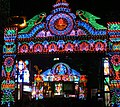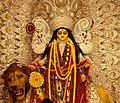Culture of West Bengal
This article has multiple issues. Please help improve it or discuss these issues on the talk page. (Learn how and when to remove these messages)
|
| Part of a series on the |
| Culture of Bengal |
|---|
 |
| History |
| Cuisine |
| Part of a series on |
| Bengalis |
|---|
 |

The culture of West Bengal is an Indian culture which has its roots in Bengali literature, music, fine arts, drama and cinema. Different geographic regions of West Bengal have subtle as well as more pronounced variations between each other, with Darjeeling Himalayan hill region and Duars showing particularly different socio-cultural aspects.
West Bengal's capital Kolkata—as the former capital of India—was the birthplace of modern Indian literary and artistic thought,[1] and is referred to as the "cultural [or literary] capital of India".[2][3] The presence of paras, which are cluster of neighbourhoods that possess a strong sense of community, is characteristic of West Bengal.[4] Typically, each para has its own community club and, on occasion, a playing field.[4] Residents engage in addas, or leisurely chats, that often take the form of freestyle intellectual conversation. However, with the growth of apartments, expansion of neighbourhoods and rapid urbanization, this culture is on decline.[5][6]
Literature
[edit]The Bengali language boasts a rich literary heritage, shared with neighbouring Bangladesh. West Bengal has a long tradition in folk literature, evidenced by the Charyapada, Mangalkavya, Shreekrishna Kirtana, Thakurmar Jhuli, and stories related to Gopal Bhar. In the nineteenth and twentieth century, Bengali literature was modernized in the works of authors such as Bankim Chandra Chattopadhyay, Michael Madhusudan Dutt, Rabindranath Tagore, Kazi Nazrul Islam, and Sharat Chandra Chattopadhyay. Coupled with social reforms led by Ram Mohan Roy, Swami Vivekananda, and others, this constituted a major part of the Bengal Renaissance.[7] The middle and latter parts of the 20th century witnessed the arrival of post-modernism, as well as literary movements such as those espoused by the Kallol movement, hungryalists and the little magazines.[8]
Theater and films
[edit]Bengal has a long tradition of indigenous theater that dates back to the 1770s and consists of popular tales enacted through dance, music, and narration. Modern theater was introduced by Europeans in the mid-19th century and sustained by colonial educational institutions. The mythological and historical plays dominated the last quarter of the 19th and first quarter of the 20th century, but gradually gave way to urban middle-class predilections in society. The Indian People’s Theatre Association (IPTA) was founded in 1943 and produced plays with far-reaching impacts. In the 1950s, amateur group theater emerged to address contemporary sociopolitical and financial issues. Star Theatre, Academy of Fine Arts, Rabindra Sadan, Nahabat, and Girish Manch are the most popular Bengali theaters, known for their development and socially conscious plays.[9] Among other types of theater, West Bengal has a tradition of folk drama known as jatra.[10][11] Kolkata is the home of the Bengali cinema industry, dubbed "Tollywood" for Tollygunj, where most of the state's film studios are located.[12] Its long tradition of art films includes globally acclaimed film directors such as Academy Award-winning director Satyajit Ray, Ritwik Ghatak, Mrinal Sen, Tapan Sinha, and contemporary directors such as Aparna Sen, Buddhadeb Dasgupta, Goutam Ghose, Koushik Ganguly, Rituparno Ghosh, Anjan Dutt, Kamaleswar Mukherjee, Sandip Ray.[13] Uttam Kumar was the most popular lead actor for decades, and his romantic pairing with actress Suchitra Sen in films attained legendary status.[14] Soumitra Chatterjee, who acted in many Satyajit Ray-films, and Prosenjit Chatterjee are among other popular lead male actors. As of 2020[update], Bengali films have won India's annual National Film Award for Best Feature Film twenty-two times in sixty seven years, the highest among all Indian languages.

Music
[edit]The Baul tradition is a unique heritage of Bengali folk music, which has also been influenced by regional music traditions.[15] Other folk music forms include Kabigaan, Gombhira, Bhawaiya, kirtans, and Gajan festival music. Folk music in West Bengal is often accompanied by the ektara, a one-stringed instrument. West Bengal also has a heritage in North Indian classical music. The state is recognised for its appreciation of rabindrasangeet (songs written by Rabindranath Tagore) and Indian classical music. Nazrul Geeti is another classical music of Bengal, which is written and composed by poet Kazi Nazrul Islam. He was person in Bengal music who created the first Bengali ghazals.[citation needed]
Popular music genres include adhunik songs.[16][17] Since the early 1990s, new genres have emerged, including one comprising alternative folk–rock Bengali bands.[16] Another new style, jibonmukhi gaan ("songs about life"), is based on realism.[18] UNESCO selected The Rural Craft Hub of Bengal to showcase their artwork in Paris in 2015.[19]
Dance
[edit]West Bengal is known for its diverse culture, and dance plays a significant role in showcasing this. Each region has its own unique dance form that not only reflects the culture and history of the area but also incorporates worldwide themes. The Brita dance is a traditional folk dance performed by women to seek blessings from the Gods for their children's wishes to come true or to celebrate recovery from illness. The Gambhira dance is a devotional folk dance that addresses social, political, and moral issues of contemporary society, and it is popular during festivals in North Bengal. The Santhal dance celebrates nature and addresses gender issues and land rights, and it is performed by both men and women of the Santhali tribe. The Lathi dance is a well-known form of dance that expresses various emotions of human life, including celebration, anger, pain, and love. Finally, the Chhau is a widely practiced tribal dance that incorporates martial arts, athletics, and religion, with stories taken from the great epics of the Ramayana and the Mahabharata.[20]
Attire
[edit]Though Bengali women traditionally wear the special Benarasi sari and Jamdani, Western attire has gained acceptance among younger and professional women.[21] Western-style dress has greater acceptance among men, although the traditional costumes like dhoti, panjabi, kurta, pyjama and lungi are seen during weddings and major festivals. Like any other metropolis, Kolkata also has an eclectic mix of western wears with a tinge of ethnic wears. People are found dressed in jeans along with kurtas, or sari along with an overcoat. women usually do a good makeup which attracts men and keeps them respected
Festivals and celebrations
[edit]West Bengal is famous for its culture and festivals are an inevitable part of this culture. Some festivals are celebrated statewide, while others are local in nature. There are also various other village fairs and seasonal tribal festivals. Durga Puja is the biggest and most important festival of West Bengal, and it features colourful pandals, decorative idols of Hindu goddess Durga and her family, lighting decoration and immersion processions. Other major festivals are Kali Puja, Diwali, Dol, Saraswati Puja, Jagaddhatri Puja, Rath Jatra, Kojagori Lakshmi Puja, Vishwakarma Puja, Poush Parbon, Poila Boishakh, Christmas. Kolkata Book Fair, Kolkata International Film Festival and Dover Lane Music Festival are major annual cultural events of Kolkata, whereas Poush Mela, Ganga Sagar Mela, Jhapan are some of the major annual fairs of the state. The diverse ethnic populace of Darjeeling Himalayan hill region celebrates several local festivals such as Losar, Dusshera or Fulpati, Tihar, Ram Navami, Maghe Sankranti, Chotrul Duchen, Buddha Jayanti, Tendong Lho Rumfaat, Eid al-Fitr etc.
-
Durga Puja, biggest festival of West Bengal
-
Glittering lighting decorations during Durga Puja.
-
Kali Puja, a major festival of West Bengal
-
Saraswati Puja
-
Rath Jatra is widely celebrated in Bengal
-
Bandel Church
-
Colours for Dol. Abir on sale at a market
-
Chhau Mask dance parforming in the field
-
Muslims gather at Muharram procession in Kolkata
-
Shops selling Christmas decorations in Kolkata
-
Poila Baisakh festive meal
-
Shoppers at the Poush Mela Fair
-
Jagaddhatri Puja in Kolkata
-
Kapil Muni Temple at Sagardwip
West Bengal has a long tradition of popular literature, music and drama largely based on Bengali folklore and Hindu epics and Puranas.
See also
[edit]- Architecture of Bengal
- Arts of West Bengal
- Bengali cuisine
- Bengal School of Art
- Bengali folk literature
- Culture of Bengal
- Culture of Darjeeling
- Culture of India
- Kalighat painting
- Music of Bengal
- Music of West Bengal
- Christianity in West Bengal
References
[edit]- ^ Chaudhuri, Nirad C. (2001). The autobiography of an unknown Indian. New York Review of Books. p. 269. ISBN 978-0-940322-82-0.
- ^ Reeves, Philip (5 April 2007). "Calcutta: habitat of the Indian intellectual". National Public Radio. Archived from the original on 2 October 2011. Retrieved 29 December 2012.
- ^ Noble, Allen and Frank Costa; Ashok Dutt; Robert Kent (1990). Regional development and planning for the 21st century : new priorities, new philosophies. Ashgate Pub Ltd. pp. 282, 396. ISBN 978-1-84014-800-8.
- ^ a b "Kolkata culture: Para". Department of Tourism, Government of West Bengal. Archived from the original on 21 December 2011. Retrieved 9 December 2011.
- ^ Trachtenberg, P. (15 May 2005). "The chattering masses". The New York Times. Archived from the original on 5 December 2013. Retrieved 26 April 2006.
- ^ Mukherjee Pandey, Jhimli (1 November 2008). "Presidency old-timers to relive days of canteen adda". The Times of India. Archived from the original on 7 July 2012. Retrieved 23 January 2012.
- ^ Dutt, R.C. (1962). Cultural heritage of Bengal. Calcutta: Punthi Pustak. cited in Sengupta, Nitish K. (2001). History of the Bengali-speaking people. UBS Publishers' Distributors Pvt. Ltd. pp. 211–12. ISBN 81-7476-355-4.
- ^ "India: The hungry generation". Time. 20 November 1964. Archived from the original on 8 March 2008. Retrieved 24 January 2012.
- ^ Chakrabarti, Kunal; Chakrabarti, Shubhra (22 August 2013). Historical Dictionary of the Bengalis. Scarecrow Press. pp. 465–467. ISBN 978-0-8108-8024-5.
- ^ Chakraborty, Ajanta (5 July 2011). "Meet the new Mamata Banerjee". The Times of India. Archived from the original on 8 July 2012. Retrieved 23 January 2012.
The jatra industry based out of Kolkata's Chitpur Road has gone through a severe blow with the growth of video parlours.
- ^ Niyogi, Subhro (26 October 2010). "Red alert For Jatra". The Times of India. Archived from the original on 7 July 2012. Retrieved 23 January 2012.
- ^ Sarkar, Bhaskar (March 2008). "The melodramas of globalization". Cultural Dynamics. 20 (1): 31–51 [34]. doi:10.1177/0921374007088054. S2CID 143977618..
- ^ Gooptu, Sharmistha (2010). Bengali cinema: 'an other nation'. Taylor & Francis. pp. 2, 172, 181, 187. ISBN 978-0-415-57006-0. Archived from the original on 30 June 2023. Retrieved 24 January 2012.
- ^ Chowdhury, S. (2021). Uttam Kumar: A Life in Cinema. Bloomsbury Publishing. p. 209. ISBN 978-93-5435-271-3. Archived from the original on 2 February 2023. Retrieved 25 July 2022.
- ^ "The Bauls of Bengal". Folk Music. BengalOnline. Archived from the original on 19 January 2003. Retrieved 26 October 2006.
- ^ a b Dorin, Stéphane (2005). "La globalisation du rock vue de Calcutta" [The globalization of rock to Calcutta]. Volume! (in French). 4 (1): 144–45. Archived from the original on 8 May 2013. Retrieved 29 January 2012.
- ^ Shepherd, John (2005). Continuum encyclopedia of popular music of the world. Vol. 3–7. Continuum. pp. 70–71. ISBN 978-0-8264-7436-0.
- ^ Bhattacharya, Malini (2005). "Culture". In Bagchi, Jasodhara (ed.). The changing status of women in West Bengal, 1970–2000: the challenge ahead. New Delhi: Sage Publications. p. 105. ISBN 978-0-7619-3242-0. Retrieved 10 February 2012.
- ^ Roy, Tasmayee Laha (5 February 2016). "West Bengal rural craft hubs help artisans double their incomes". The Economic Times. Archived from the original on 13 February 2018. Retrieved 13 February 2018.
- ^ "music and Dance - Egiye Bangla". wb.gov.in. Archived from the original on 18 March 2023. Retrieved 23 May 2023.
- ^ Yengkhom, Sumati (23 September 2010). "This Puja, buzz over western clothes". The Times of India. Archived from the original on 11 July 2012. Retrieved 23 January 2012.















